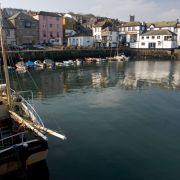The River Fal
As well as being a huge resource for sailors and fishermen, the river provides an important habitat for birds and wildlife. Along much of its upper course the banks of the river are wooded and home to fallow deer, perergrine and buzzards. Goss Moor is a national nature reserve, its heathland and wetland environment of international importance. Birdwatching facilities are available at Sett Bridge, after which the river sweeps in a great curve to join the Truro River at the Tolverne Passage.
The Truro River is one of six main tributaries that eventually flow with the Fal into the Carrick Roads, along with twenty-eight minor creeks and rivers, many of them, such as the Penryn River and Restronguet Creek, navigable by boat. Along the entire reach of the river there are around four thousand five hundred moorings available for anything from yachts to deep water freighters, which are often 'mothballed' here during times of economic crisis, their incongruous size lending an eerie atmosphere to the picturesque estuary.
King Henry VIII's Castles
The seaward entrance to the Carrick Roads is a mile wide and guarded by a pair of striking castles, built by Henry VIII between 1539 and 1545, in order to protect this important harbour from the threat of invasion by France or Spain. On the Roseland side, St Mawes Castle is among the most elaborately-decorated and best-preserved of all Henry VIII's 'Device Forts', a quick surrender having protected the castle from damage during the civil war. The castle is managed by English Heritage and has a central tower overlooking three huge circular bastions attached in a clover-leaf pattern to the sides, with gun ports covering every possible angle of approach to the estuary. On the Falmouth side stands the larger Pendennis Castle, also managed by English Heritage. Here, a simple round tower and gate are enclosed by a lower curtain wall. Unlike St Mawes, Pendennis Castle, the last Royalist stronghold to fall in the whole of the west of England, suffered extensive damage during the civil war. Around fifteen hundred men, women and children managed to survive a one hundred and fifty five day siege before being forced to surrender due to starvation. The castle was later used as a secret second world war base.The best way to explore the River Fal has to be by boat, and numerous ferry boat and sightseeing companies criss-cross the estuary. During the summer boats leave for Truro every couple of hours from the Prince of Wales pier in Falmouth, a journey that takes around an hour and provides amazing views of the river and it's banks.
Most ferries first call at St Mawes, a picturesque town that lies at the mouth of the Percuil River, a charmingly unspoilt and navigable tributary of the River Fal, with wooded banks managed by the National Trust. Ferries run across the Percuil River during summer, linking St Mawes with Place, on the Roseland Peninsula, and saving walkers on the South West Coast Path an eight mile detour. From Place it is possible to walk out to the wild and windswept St Anthony Head, where a lighthouse warns ships of dangerous rocks known as the Manacles. Most ferries also stop at Tolverne, where you can disembark for an excellent cream tea.
Continuing upriver will soon bring you to the waterside pontoon at Trelissick, home to one of Cornwall's finest woodland gardens. Two stunning three-mile circular walks allow you to explore the five hundred acres of parkland free of charge, skirting some of the River Fal's peaceful creeks. The twenty-five acre garden itself, within easy walking distance of the pontoon, is managed by the National Trust. The garden was donated to the Trust in 1955 by Mrs Ida Copeland, and many of the garden's famous Rhodedendrons and Azaleas were planted by the Copeland family, whose business was a china factory and who used the rare and exotic plants as inspiration for their designs. Trelissick's magnificent array of exotic plants includes Camellias, Magnolias, Rhodedendrons and rare Hydrangeas, as well as the National Plant Collections of Photinias and Azaras. The head of a previous family, Sir Humphrey Gilbert, was lost at sea in his tiny ship, 'Squirrel' after discovering Newfoundland!Ferries usually carry on all the way to Malpas and Truro, passing through the very deep King Harry Passage, part of the ancient pilgrim's route to St Michael's Mount, on their way. Here the oldest chain ferry in the country, the King Harry Ferry, shuttles backwards and forwards between Feock and Philleigh, saving cars, and their drivers, a twenty-seven mile detour. One of only five chain ferries in England, the King Harry Ferry departs every twenty minutes, seven days a week, all year round. Named after the Lancastrian King Henry VI, the new ferry has a glass side and chain viewing windows and a touch-screen information display in order to help passengers better understand the River Fal.
More ferries nip across the estuary to Flushing, on the other side of the Penryn River to Falmouth. From here you can walk along the coast path to Mylor, rounding Trefusis Point, where steps and a cave have been cut into the rocks, in order to transfer illegal contraband from boats to the shore in the days of smuggling. The cave marked the entrance to an old tunnel that led up to the cellars of the estate house on the hill, where the goods were stored. More ferries (summer until 10pm) run back to Falmouth from Mylor.For those who wish to explore the river for its own sake, a couple of companies run wildlife watching and coastal boat trips from Falmouth including the Orca Bay Discovery, on their purpose-built twelve-seater RIB, the 'Seaquest of Falmouth'. Expect to see anything from Dolphins, Seals and Basking Sharks to giant Conger Eels and even Orca! For a gentler experience, Newman's Cruises run a couple of classic wooden ferries from Smuggler's Cottage in Tolverne, the classic boats' shallow draft making them ideal for exploring the shallower reaches of the River Fal.
Many of the smaller creeks and inlets that feed the River Fal make excellent territory for exploration by kayak or canoe, while some of the larger ones, such as Restronguet Creek, which is tidal as far as Devoran and Perran Wharf, are navigable by yachts and other leisure crafts. Mylor Creek, which winds its way inland to Mylor Bridge, is also navigable by boat, as is St Just Creek, inland from the Percuil River, on the eastern side of the river.
The River Fal has a value that goes far beyond the merely picturesque, however. Falmouth has a long and illustrious nautical history, renowned for its association with the mail packet boats. Penryn, which dates back to the 14th century, was once a bustling port handling large cargoes of tin, granite and coal, while Truro has been a port in it's own right since 1170 and continues to attract coastal vessels up to eighty five meters long. Today the river continues to feed the local economy not just through tourism but through shipping support industries such as bunkering, cargo handling, rigging, sailmaking and marine engineering. The most striking industry to survive on the River Fal, however, must be oyster fishing.Oyster Fishing on the Fal
Oysters have been harvested on the River Fal in the same traditional and highly sustainable fashion, without the use of mechanical power, for more than five hundred years. Thought to have been found in Cornwall since the days of the Phoenicians, oysters were being widely grown along the whole Cornish coast when the Romans invaded, and by 1602 they were being caught in much the same way as they are today, using thick, strong nets, called dredges.
Oysters are an unpredictable species that can be difficult to harvest and oyster fishing is a skill that can only be learned through years of experience. Although most oyster fishermen in Falmouth have other seasonal jobs, for the most experienced and committed fishermen oysters provide a decent year-round livelihood.
In 2006 a festival celebrating life on the River Fal was set up. More than one hundred and thirty events take place over ten days, celebrating the music and drama, literature, arts, industrial heritage, walking and watersports that the river inspires. The Falmouth Oyster Festival is held in late May / early June.











